Email marketing is quite popular and we have all been hearing about it for some time now. However, it is also very effective for growing a brand as well as selling products.
In fact, emails are one of the best marketing tools out there. Through email, you can inform your customers and subscribers about new products, services, offers, discounts, promotions, etc.
Moreover, other than promoting a company’s products & services they can also be used for incentivizing your customer loyalty.
You can use emails to educate your audience about your brand’s value or keep them engaged in between purchases, plus anything else that may fall in the middle.
You can use tools like Moosend which is an email marketing platform that can assist you in designing and building a successful email marketing campaign, and maximize the return on your marketing investment.
Email marketing is popular, but it is also very effective for growing a brand or selling products.
This email marketing guide will tell you everything you need to know about how to use it to grow your business, sales, and income.
What is the definition of email marketing?
Email marketing is a high-level marketing tool that utilizes email to promote brands, products & services.
We can call it the perfect blend of digital and direct marketing.
Not only can you use it to keep your customers informed of your latest products and offers or to keep them engaged between purchases, but also for generating leads, raising brand awareness, and strengthening relationships.
History of Email
In 1971, Ray Tomlinson, a computer engineer, initiated the incredible new era of communication by sending the first email. It was not his job to do this, but rather it was a personal side project that he had been working on.
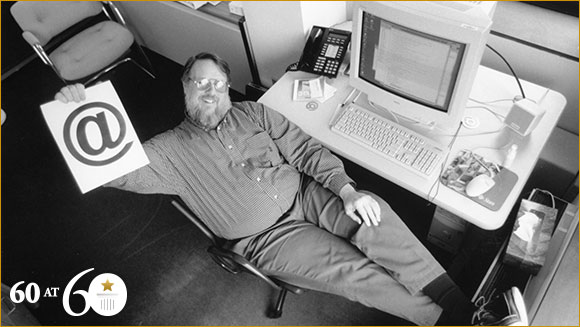
That email was just an experiment to see if two computers could communicate with one another and exchange a message. The message it contained was nothing but a series of numbers and letters that made history.
Tomlinson is also famous for popularizing the use of the \"@\" symbol in email addresses.
Besides, it was also Ray who decided to use the “@” symbol to separate the recipient’s name from their location. And no matter how much the format of email has changed over time, the “user@host” is the standard for all email addresses used today.
The First Business Email Was Spam


In 1978, Gary Gary Thuerk a marketing manager at Digital Equipment Corp sent the first business email about a new computer to 400 recipients. And back in those days that email generated the company $13 million in revenue.
By the ’90s, the internet had become commercially available to the masses. Which began to shift communication styles dramatically, making marketers realize that email could be a powerful marketing tool.

The introduction of marketing emails also necessitated regulatory changes; the Data Protection Act in the United Kingdom, for example, was amended to require an \”opt-out\” option for all marketing emails.
12 Fundamentals of Email Marketing

Columnist Mary Wallace, a leader in marketing automation and marketing technology, has offered some guidelines for newbies and veterans alike on email marketing fundamentals. She emphasizes that modern technology is useless if you don’t get the foundations right.
And, as modern marketers, we’re under a lot of pressure to make our email campaign work — they need to increase engagement, conversions and, most importantly, drive sales and revenue.
Due to our busy lives and exposure to different email marketing services and email marketing tools, it has become easy to overlook the fundamentals of automated emails performance.
Here are 12 tips and techniques to help you get started and create effective email marketing campaigns for your brands and products.
1) Keep Communication Human
Unless you’re a well-known and recognized brand like Coca-Cola, emails sent by a person (e.g., ‘Alan Smith’) engage far better than emails sent by a company (e.g., ‘Smith & Co’).
2) Avoid average-length subject lines.
For best performance, keep your subject lines either long or short. They are the vital driver to your opened email rate, and those with 60 to 70 characters neither impact the open rates nor engagements.
According to research, subject lines with more than 70 characters increase the click-through rate, whereas shorter subject lines with lower than 50 characters improve the email open rate.
3) Keep Your Email Content & Subject Line Relevant
Excellent subject lines can boost your email open rate, but unless the content of the email is also relevant to the subject line, there won’t be any engagement.
Even worse, an off-topic subject line may cause a recipient to mark your email as spam.
4) Keep Email Content Short & Simple
Do not stuff your email draft with endless walls of text. If you overload your reader with words, you’ll lose their interest. Eleven seconds is the average read time for an email.
It is better to write short, concise emails that should stimulate the reader’s appetite and focus on one topic at a time.
Include most details on the landing page that the reader will see after clicking on your emailed link.
5) Highlight Benefits & Value
People dont care about your products or services or the features and functions you have put into them.
People care about the value and benefit they will enjoy after using your product or service.
For better engagement, it is crucial to add compelling phrases and words to make them check your offer and click on your link.
6) CTAs (Call-To-Action) Buttons Placement
It is always a good idea to place your Call-to-action buttons above the fold and not at the bottom.
Use several call-to-action buttons, but make sure to put at least one above the fold.
Should all call-to-action buttons lead to the same landing page? Or should there be choices for the reader?
Looking at how email readers have evolved, communications involving multiple target locations have achieved far better results than communications involving a single place.
7) Put Your Links First
Ideally, your link should be visible in the first line of your email text.
Try to connect the link to the first few words of the first paragraph. That is where the eye goes as soon as the email is opened, and by placing your link there, you increase your chances of getting email clicks.
8) Make CTAs (Call-To-Action) Text Appealing
In your call-to-action buttons, use words that represent value and benefit to the reader.
Texts like Call Now’, ‘Contact Us,’ ‘Click here, ‘Download,’ or ‘Submit’ are too overused and will not generate significant results.
Instead, use words or phrases like ‘Get Free Trial’ or ‘Avail Benefits Now.’
Even better if you use ‘Get My Free Trial’ or ‘Avail My Benefits Now.’
9) Accuracy Is More Important Than Personalization
Personalization is great. But make sure your email contacts list or subscriber database is updated.

Unless you are 100% certain of their exact name and how it is spelled, it is better to start with ‘Dear Sir’ or even a ‘Hello.’
An email that begins with a misspelled or incorrect name is a huge turnoff.
10) Use A Responsive and Easy-to-Read Layout
Create emails easily readable on any device, whether mobile, desktop, or tablet.

Enhance legibility by using large fonts in a one-column layout. Email width of most designs today are between 600px and 700px.
Note: Pick a width that is optimal for your email design and the complexities of your layout.
11) Make Good Use of Color
Colors grab attention, and they can help draw the eye where you want it to go. It does not mean that you must have several different colors to highlight different sections of your email.
Secondly, adding a specific color to a call-to-action button will not necessarily increase conversions.

Colors In email marketing have their significance. My simple advice is to make the call-to-action button stand out and make it more prominent by using a single bright color from the email’s color palette.
12) Use High-resolution Images
Images engage readers. Use quality images; that is clear and appropriate in theme and size to go with the email format and content.
Email Marketing: Misconception & Reality
You may have heard your coworkers talk about how email marketing is dead, and many marketing departments have been concerned about this.
Let me clarify three things:
- Email Marketing is very much alive
- It has evolved and is here to stay
- And it is getting stronger each passing day
I say this because 40% of B2B marketers say email newsletters are essential for their content marketing strategy, and 73 percent of millennials communicate with businesses via email.
Furthermore, 99 percent of consumers check their email daily, making it the most popular to receive different brands update.
Marketers cannot ignore these stats; hence, a foolproof email marketing strategy is essential for them. It may sound challenging with a lot to work involved but considering the value and benefits that you get makes it all worthwhile.
The 12 Email Marketing Benefits You Must-Know
Let me share the top 12 benefits that make Emails one of the most effective marketing channels globally.
1) Allows Personalized Content Creation
One of the most amazing advantages of email marketing is that it allows you to tailor your content to the specific needs of your audience.
Personalization can be as simple and basic as addressing the contact in your email by name. And emails with the recipient’s first name in the subject line get more clicks.
Sending the correct email to the right people at the right time is essential for a successful email marketing strategy. Segmentation and personalization can help in this situation.
Segmenting your audience allows you to create personalized content and send the relevant emails to the appropriate customers. For example, you might want to use email marketing software to send one email marketing campaign to repeat customers and another to new customers.
Your emails can include different images or subject lines to ensure better engagement. You can even segment your lists by geography or engagement level.
2) Helps Collect Information & Feedback.
If you want to build constant contact with your customers and want them to continue interacting, engaging, and purchasing from your brand then keeping a check on the customer experience is essential.
This can be accomplished through email marketing. Customer satisfaction surveys, for example, can be sent via email campaigns to obtain feedback from customers.
It is one of the most effective methods for determining your Net Promoter Score (NPS) which can help you determine the percentage of customers who are brand advocates or brand detractors.
With that information, you can develop strategies that are bound to enhance customer experience.
3) Increased Revenue
Email automation is an excellent marketing tool and if done right your future campaigns can significantly boost revenue & sales.
You can use your email marketing efforts to promote products and services, encourage customers (who have abandoned their carts) to buy, or repeatedly inform them of special offers.
Moreover, 59% of those polled have admitted that marketing emails impact their purchasing decisions.
Because they’ve opted-in to receive your messages and updates, your email marketing campaigns can easily include messages to encourage a purchase from an audience that’s more likely to buy from you.
Additionally, you can use it to automate a portion of your sales process to boost your sales. For example, using this free email marketing tool from HubSpot, you can try automating your sales drip campaigns and sending automated messages to prospects that your sales team would want to follow up.
4) Building Better Communication with Your Audience.
As a marketer, it’s crucial to keep working on and improving your communication with your audience. Your audience is more likely to become loyal to your brand once they feel they can communicate with you.
Think about it: Good emails are always appreciated. For instance, the last time you received a marketing email from your favorite brand: was it annoying? Did you or did you not enjoy reading it?
When my favorite brands email me, I hear about the latest updates on their products or services, what they are about to launch next, or the technology they would be using now. I enjoy the experience and appreciate the information they have sent, and probably you do too. Besides, it is a great way to keep in touch with brands you love.
Use email marketing to reach a bigger audience and to better communicate with brand ambassadors. Furthermore, these emails keep your audience engaged whether it’s a slow or busy season.
5) Increasing your website’s traffic.
How do you ensure your great content reaches your audience? By email.
Email marketing is a great way to drive traffic to your website and improve SEO. Plus, it will keep your visitors engaged with your brand and website.
I do it and love it because I see emails as a great way of providing value to my audience. What else is better than sharing valuable information and getting more traffic?
Just make sure to include a call to action (CTA) in each email that links to your content so that readers get to visit your website.
6) Campaigning More Time To Time
Timing is everything. Traditional campaigns have a time and place, but planning and organizing them can take months. Even then, there is no way to be sure if your campaign assets will be seen at the right time.
Email marketing comparatively takes less time to plan and execute. Hence, you can create your campaigns at shorter notice. Plus, you can even ensure that your readers receive the email just at the right time.
Please take my advice and do what I have done. I have arranged my audience into segments. It allows me to send the right content to the right audience at the right time. Easily!
7) Lead generation.
Thats right! Not only can email marketing help increase your sales, but it can also help generate more leads. And, when combined with inbound marketing techniques, emails can undoubtedly nurture leads and improve conversions.
For instance, you download a lead magnet from a website, which starts a chain of drip emails. Then finally, you decide to schedule a demo because you gained interest, and now you want to learn more.
This move upgraded you from an MQL to SQL and increased the number of qualified leads available to the sales team.
Email marketing campaigns can help your sales team further qualify leads, saving precious time which they could have wasted with incorrect or incomplete information. Additionally, if your company uses lead scoring, you can track whether or not those leads opened your emails or got engaged by clicking the links you had put in.
8) Reach out to the Right People at the Right Time
You need to reach the right customers at the right time to have a successful marketing campaign. Yes, I know that I’m repeating myself because this is a critical point.
Most of us check our emails daily. Sometimes twice or even more in a day. And I am sure that is the case with most of my readers.
Because people check their emails frequently, email marketing does make it easier to reach out and connect with them. Your readers can access the email anytime and from any device, which indirectly improves the marketing campaign’s chances of success.
It is one way of repeatedly putting yourself in front of your target audience, ensuring that you’re always at the top of their mind.
9) Creating cost-effective campaigns.
Email marketing is more cost-efficient than traditional methods such as print or direct selling. And this is very well understood because you don’t have to pay for photoshoots, locations, printing, mailing, or placement.
All you need is someone who can write. And just in case if you are not planning to use stock images then you may require a graphic artist.
Ideally, you can find one guy who can do both jobs.
Furthermore, you can create email marketing campaigns quickly. You can create one within a day and these are more cost-effective than a direct or print campaign.
Since marketers are always short on time and money, these campaigns could be the thing for them. Email marketing is undoubtedly more efficient for generating more revenue and leads.
10) Increase the value you provide to your audience
One of the most important goals of any business is to provide value to its customers because they want to ensure that they keep coming back.
Email marketing is great for turning prospects into loyal customers. The reason is that with it, you are adding value even when the customers aren’t making purchases.
Another thing is that since customers or prospects have subscribed to receive your emails, you can provide them with more valuable resources using email marketing.
And more people will start paying attention if you consistently provide value to your audience, eventually leading to a higher ROI.
11) Having a place to promote yourself
Self-promotion in places where prospects haven’t necessarily opted-in to receive updates about your business can land you in awkward situations.
On the other hand, self-promotion is also known as one of the most effective ways to attract customers. And you must know how to market yourself and sell your business; if you expect and want people to buy from you.
Email marketing provides excellent opportunities to promote yourself using email campaigns in front of an audience that has already opted-in and has confirmed their interest in your products and services.
Use emails to announce a new product, features, benefits, or even fresh content. Since your audience has subscribed to hear from you, this kind of self-promotion will not be unwelcomed nor appear odd.
12) You Own Your Media and Contacts List
You don’t own your contacts or even the content you share on social media.
Everything shared or found on a social media platform is owned by that platform.
Yes, they hold your content as well as the list of your contacts. Now imagine the number of connections you may lose if that platform disappeared?
This one possibility makes building an email list essential to marketers. Once you have created a list of potential contacts, you can build communication and improve over time. Plus, you get to own the content you produce, publish, or email.
The 10 Different Most Effective Marketing Emails
The Most Effective Marketing Emails Come in a Variety of Forms.
Many small business owners find it challenging to develop an email marketing strategy. They hardly get time to plan anything other than announcements and promotions.
However, they need more than that to keep their subscribers interested and engaged. Ideally, your emails should be something they look forward to reading. This behavior confirms that they recognize your company even if they are not your customers yet.
In simple words, you need to have different kinds of emails sent at other times.
This walkthrough will guide you on using different email campaigns to keep your audience engaged while generating more sales.
Types of Marketing Emails
Marketing emails in general fall into two broader categories
- Engagement
- Transactional
Simply put, engagement emails are about telling a story, whereas transactional emails are about making and closing a sale.
However, they share their attributes in many cases, meaning that an engagement email will contain certain transactional elements.
Keep this point in mind as you read through the various emails types listed below.
Marketing Emails Type 1: Emails For Engagement
These emails are more focused on branding and storytelling and not making direct sales. The purpose of these emails is to keep the audience engaged with the brand even when they are not going to buy anything.
Engagement emails, in a way, ensure that potential buyers will have an active ongoing relationship with your brand when they find themselves ready and prepared to make a purchase.
The good thing about these emails is that they allow the freedom to be creative. Sometimes adding little extra visuals or inserting video and audio links can prove extremely effective in some cases.
You can use the following types of engagement emails:
1) Welcoming Emails
The first email your subscribers receive after sharing and confirming their email address with you; is when a visitor has converted into a lead. This email has to be memorable and worthwhile for the subscriber, as it will be their first interaction with your brand in their inbox. HubSpot analyzed email metrics of 19,033 customers to calculate the open, click-through, hard bounce, and unsubscribe rates of each industry from November 2018 – November 2019. A good email open rate met the average rate of around 20.94%. A study by Marketing Sherpa found that welcome emails were THE highest performing message – measured based on the open rate – with an average rate of 50%.TheBloggingBox Tip 101: You can use your Engagement Welcome Email as a Transactional Email also.
Since the welcome email has such a high open rate, it is wise to use it also as a transactional email. According to a study, welcome emails have higher transaction rates and revenue per email than other transactional emails. It is why, as shown in the example below from skin and body care brand Josie Maran, welcome emails frequently include discounts as well as the option to shop now.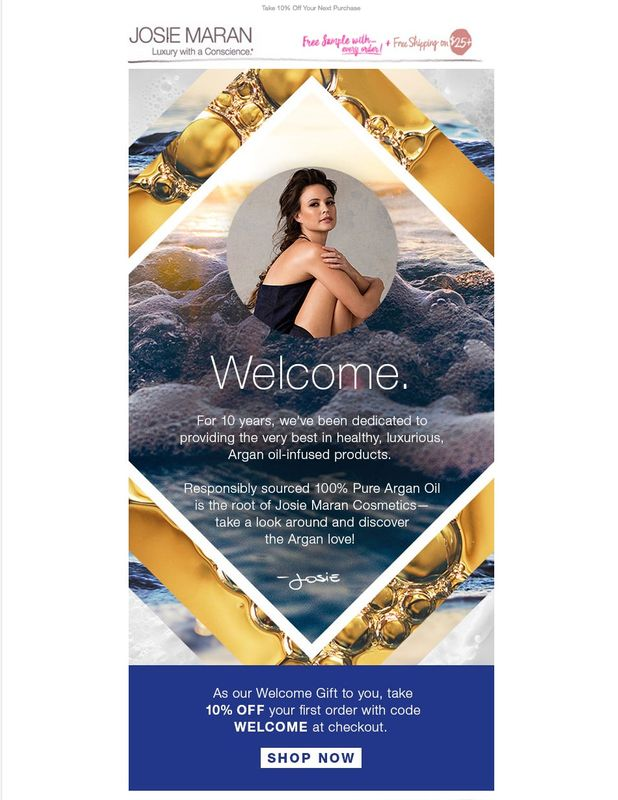
2. Tips & Tutorials
Sending informative and educational emails to your subscribers that are relevant and beneficial to them is a great strategy to win their interest.

3. Real Customer Stories
Study or Interview your customers to generate stories. These stories could be about their positive experiences with your products or services, personal experiences, or advice for other similar customers.

4. Your Brand Stories
Unlike customer stories, which are written from your customers’ perspective, brand stories are written by you or your team.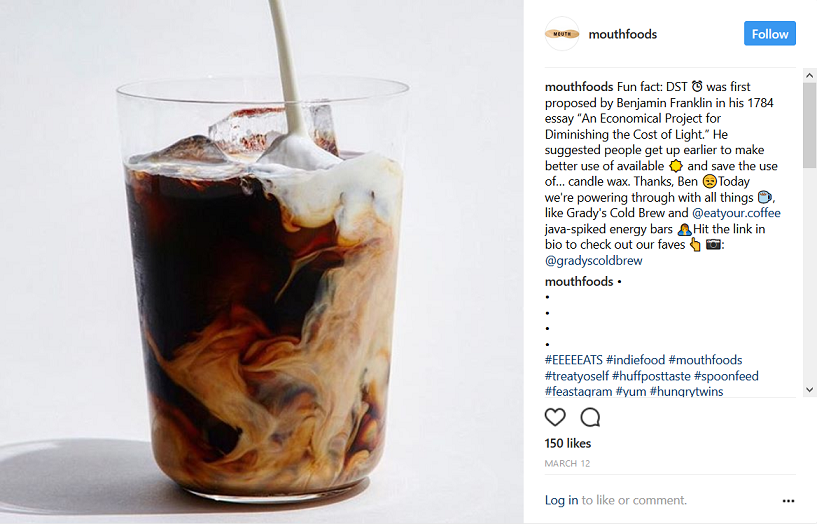



Marketing Emails Type 1: Emails For Transaction
Re-engagement Emails
Re-engagement emails are meant to grab the attention of customers who have been disengaged and out of touch for a while. Probably they were not as enthusiastic as other subscribers. Or maybe you hadn’t been updating them for a while, or perhaps they changed their mind or are not interested in your email. Whatever the situation, it is crucial to get their attention back on your brand.
The Two Types Of Re=Engagement Emails
The same study points out the two types of re-engagement emails that are most effective.5. ‘Miss You’ or ‘Come Back’ Emails
The first type is those with \”miss you\” or \”come back\” in the email subject line. The email below from REDBUBBLE is an example of this. It clearly says \”we miss you,\” and it entices the reader by giving a 10% discount on anything they like.
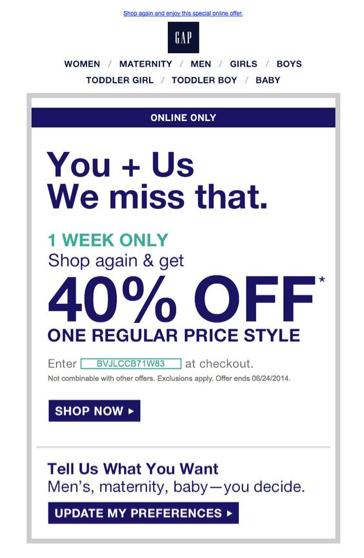
6. Dollar-off Discount In The Subject Line
Another option for a re-engagement email is to include a dollar-off discount in the subject line, which performs twice as well as percentage discounts.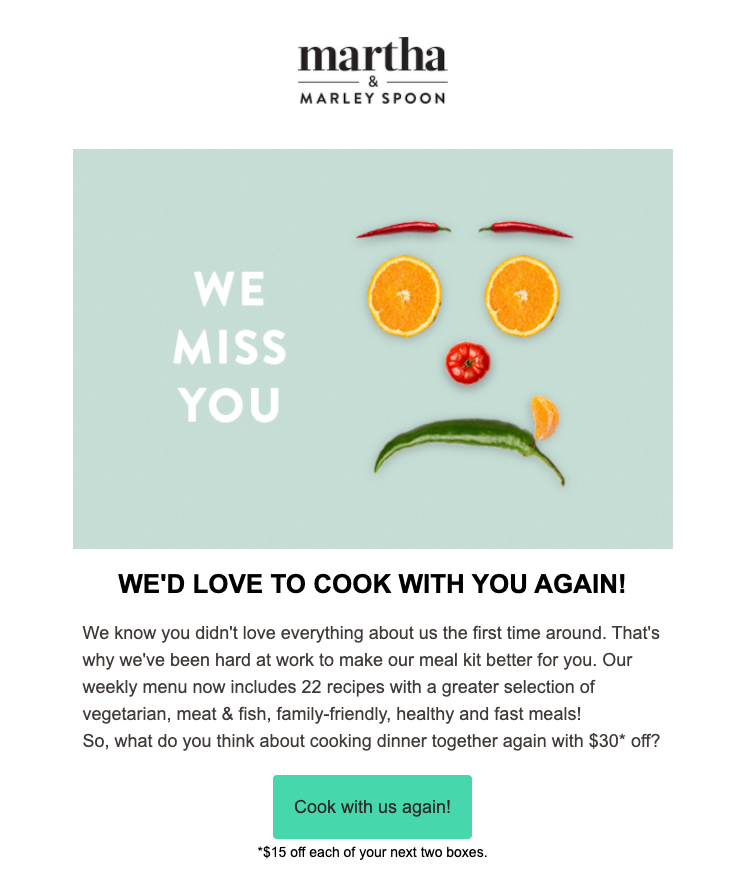

Use Personalized Text
The example above shows that Virgin Atlantic has personalized compelling text that says, \”Smiles Davis, you’re are so close…\” This kind of text gives the impression that you are talking to the customer directly, reminding them how close they are to travel. Plus, it has 3 CTAs. They have also put in the flight details to make sure the email contents have everything that can assist the customer in completing the transaction successfully and with ease. Use simple messaging in your abandoned cart emails. The basic structure outline of these can include:- Concise Subject Line
- Text for Introduction
- List of Items in cart
- Discount or Offer
- CTA (call-to-action) Complete Purchase Button
- Social Proof or Reviews
- End text

TheBloggingBox Tip 101: Send the abandoned cart email within one hour (or less) of abandonment. Because 90% of e-commerce leads go cold within the first hour!
7) Promotional & Time-Sensitive Offers
These emails are those which have an offer that is soon to expire. The stated reason for this offer may vary. It could just be a special limited-time discount to boost sales, or it could be because of the limited availability of the product. The subject line of these emails must contain the time-sensitivity element to create the urgency for the customer to open it as soon as they see it. The CTAs should be short and sweet.

Offer Incentive For Referral
This email from UberEats is a good example. The best thing about it is that it gives clear information about the offer and how it works in its main paragraph, through which the subscriber knows that they need to share the code to avail of this offer and redeem $20. Second, it has a C TA in green color, which is hard to miss. The main purpose of these emails is to push the reader to take action within the given time.8) Email Receipts
It is common for online retailers to send receipts via email or order confirmations once a customer has completed a purchase. However, besides just mentioning the bought product details you can get a bit creative to get some more returns from your email receipts.
Use Future Discount As Incentive

Recommend Other Products


Use Customer Story
 The second thing you see after the welcome note is a customer story and testimonial in which another member is sharing his great experience of being able to save tons on the registration fee plus getting a free entry to their community gathering.
The second thing you see after the welcome note is a customer story and testimonial in which another member is sharing his great experience of being able to save tons on the registration fee plus getting a free entry to their community gathering.
 And right after that are all the transactional/promotional elements that are kept there on purpose because the recipient will see them closely while scrolling down to find the order and billing information.
And right after that are all the transactional/promotional elements that are kept there on purpose because the recipient will see them closely while scrolling down to find the order and billing information.
9. Sales & Order Confirmation Emails
If you are into selling physical products the odds are your customers have to wait before they receive their consignment. Use this time to send post-transaction email updates on the current status of their order.
Use Emails To Sell More
Then here is a great example from the Dollar Shave Club that you can use to cross and upsell your products.
10) Review Requests
When you know that a customer is satisfied with your services it is smart to roll out an email requesting their review or testimonial. Testimonials are the best performer hands down especially when it comes to turning leads and interested prospects into sales. You can share a good testimonial on your website, blog site, online store, social media platforms, and even on third-party review sites. Reviews and testimonials help you win the trust and confidence of your audience with relatable stories. According to Marketing Sherpa, these endorsements have proven to help improve the clickthrough rates by 25%.Getting The Message Across Using Visuals
Amazon seems to be doing it really well.
It uses visuals in form of stars to ask how many out of five would the customer give to the product. Just by looking at the image, the recipient understands what is being asked; and as they click on it they are directed to a page that allows them to give the product a star rating; plus leave a text testimonial.
Using Old Reviews To Get New
Then Biscutteers has also done a pretty smart job by using older testimonials to get new ones. At the top, they have asked their customer to share with them what they think; by clicking on the CTA and writing a review of their brand and product.


